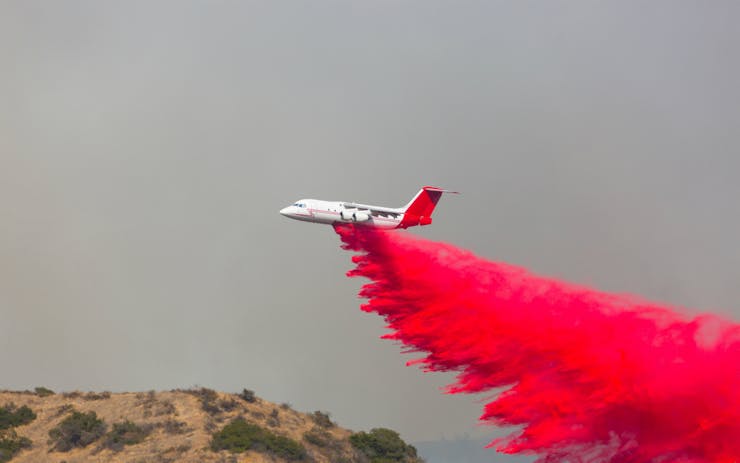Editor’s Note: This article originally appeared on the website of Project CBD, the California-based nonprofit dedicated to promoting research into the medical uses of cannabidiol (CBD). It is reprinted here with permission.
The October firestorms raging in Northern California have incinerated nearly a quarter million acres and displaced more than 100,000 residents. Heavy smoke has blanketed the skies in the nine-county San Francisco Bay Area, poisoning the air to an unprecedented degree and prompting air quality alerts and health advisories throughout the region.
This is not a typical fire. Its extreme heat melted gas pipes, power lines, even a cellphone tower. That released dangerous toxins into the air.
“We have never recorded higher levels of air pollution in the Bay Area,” said air district spokeswoman Kristine Roselius.
While a limited number of deaths have been reported thus far, the public health impacts of this disaster will be felt for many months to come.
This is not a typical wildfire. In Santa Rosa, flames have melted gas pipes, power lines, even a cellphone tower. The blaze has scorched thousands of homes and cars, releasing metals into the air. When rubber, fiberglass, paint, and electrical equipment burn they release uncommon and highly dangerous toxins, such as dioxins and other biphenyl compounds.
Poisons contained in the smoke will slowly fall from the air and be absorbed by plants and the watershed, contaminating agricultural crops, including those in the Emerald Triangle, America’s cannabis breadbasket.
The timing couldn’t have been worse for cannabis farmers, as these fires came at the start of harvest season.
What Cannabis Consumers Should Know
Cannabis producers and consumers need to be cautious about the chemicals that could accumulate.
There are three common ways that toxins and carcinogens in smoke can be removed from the atmosphere:
- Volatile chemicals like formaldehyde and carbon monoxide will dissipate by reacting with trace gasses in the air, perturbing the concentration of ozone and other gasses. When carbon monoxide reacts with oxygen radicals, for example, it converts to carbon dioxide.
- Hardier chemicals may be removed from the sky by wet deposition, whereby rain pulls pollution out of the atmosphere. But that requires precipitation. And if it rains, highly toxic run-off will pollute the watershed.
- Other chemicals will simply fall from the sky and deposit onto plants, soil, and other solid surfaces. These compounds include benzene, polycyclic aromatic hydrocarbons, and dioxins. The chemicals that settle on cannabis or nearby water and soil can be absorbed by the plant and passed on to the consumer. Cannabis, a bioaccumulator, will uptake heavy metals that have deposited on the ground and worked their way into the soil.
While these toxins can pose serious health hazards, it’s important not to exaggerate the potential harm. Cannabis smoke (even from untainted, organically grown cannabis) also contains carcinogens, but smoking marijuana does not increase the risk of oral and lung cancers—possibly because THC, CBD, and other plant cannabinoids exert a direct anti-tumor action against oral and lung cancer.
Another factor that may mitigate harm from inhaled cannabis smoke is the inhibition of a group of enzymes called CYP1A. Polycyclic aromatic hydrocarbons become more carcinogenic when metabolized by CYP1A enzymes in the body. Cannabinoids inhibit CYP1A in the lungs, and by doing so they could reduce the activation of these carcinogens.
Putting it in Context
In cannabis smoke, roughly 0.5% of the plant material converts to polycyclic aromatic hydrocarbons. That is 5,000 parts per million by weight (ppm). Carcinogenicity of aromatic hydrocarbons is usually discussed at concentrations on the order of 10 ppm.1 It remains to be seen if toxins deposited by the fires will be greater than the concentrations normally found in cannabis smoke. If not, then this cannabis is likely safe to consume (though it may require a warning under rules established by California’s Prop 65).
To reduce possible risk, vaping and consuming edibles may be better than smoking cannabis from the fire region.
To reduce further toxicity, it would be best for people to avoid smoking cannabis tainted by the wildfires: vaporization and ingestion may be better alternatives.
Consumers should also be aware that extraction processes (including butane, ethanol, and CO2) may concentrate these unwanted chemicals, though this is not precisely known. Cannabis producers and consumers should make sure, if possible, that any lab tests apply to the final product, not just the plant material that was used for extraction.
Shop highly rated dispensaries near you
Showing you dispensaries nearAccurate testing is paramount. Unfortunately, some cannabis labs have a record of providing results before they have validated their methods and can be certain that their numbers are correct. (Validation involves spiking precise amounts of contaminants into clean cannabis samples to ensure that accurate results are obtained.)
Common and Uncommon Toxins
Several fire-generated toxins that may be deposited on cannabis crops—including benzene and toluene—are on the list of regulated solvents that California labs will likely have to quantify in cannabis products as of 2018. In preparation for the upcoming regulations, analytical labs may have already validated methods for detecting these compounds.
But other, less common toxins, such as benzopyrenes and polychlorinated dibenzo dioxins (PCDDs; sometimes simply called dioxins), are not included in the new regulations. Dioxins are particularly important: They are formed when chlorinated plastics burn. PVC pipes are one of the most common examples of chlorinated plastics. One kind of dioxin, which is called TCDD, disrupts endocrine, immune, and reproductive systems as well as fetal development. It is also a carcinogen at larger concentrations. TCDD was a contaminant in Agent Orange, the chemical weapon created by Monsanto and used in the Vietnam war.2
Whether mandated by state regulations or not, cannabis labs should also test for these compounds.3 Thus far, however, cannabis labs have not validated testing procedures for these compounds.
Another concern: Helicopters and planes have been dumping tons of fire retardant in an effort to contain the fires. The fire retardant used, another Monsanto-designed product called Phos-Chek, may have adverse health consequences. One of the main constituents of Phos-Chek is ammonium salt. Ammonium is a fertilizer. If absorbed through the plant, it is unlikely to be toxic, but consumers should avoid smoking or vaporizing ammonium stuck on cannabis resin.4
We at Project CBD hope that California cannabis testing laboratories will validate methods and offer tests to detect the major contaminants that result from this month’s wildfires. We expect these to include benzene, toluene, benzopyrenes, and heavy metals, as well as some dioxins and polychlorinated biphenyls.
Footnotes:
Parts per million is a unit that can cause some confusion. It can mean concentration by weight (ppmw) or by volume (ppmv). When discussing cannabis and lab tests, parts per million is measured in weight: ppmw means microgram of contaminant per gram of cannabis. (A microgram, written µg, is one millionth of a gram.) But when talking about safety data, especially for inhaled compounds, parts per million is usually micrograms of contaminant per liter of air. This makes it much easier to determine the concentration of contaminants in a person’s lung. Since an adult human’s lungs contain about 4-6 liters and a joint weighs about half a gram, ppmv is roughly 10 times larger than ppmw. In other words, the lab test for a contaminant should be no more than 10 times larger than the safety parameter for inhaling that contaminant. This is a rule of thumb, not a definitive statement. See the report in footnote 4 for more information on safety data.
TCDD is pervasive in the environment. It can be found at low concentrations in milk and meat, with beef being the worst offender. This is partly because dioxins are extremely durable compounds—the half life of TCDD is close to 10 years. The average human body has roughly 1-5 parts per trillion dioxin in their fat tissue (that is, 1-5 picograms of dioxin per gram of fat). These levels have been declining greatly since the 1970s.
This list is not finalized. The proposed regulations were repealed after the public comment period by the trailer bill, the bill that merged recreation and medical cannabis regulations. The new regulations have not yet been released.
Inhaling ammonia in cannabis at concentrations below 100 ppm is likely safe. 100 ppm means 100 µg ammonia per g cannabis product. The number is based on the equation described Appendix A of this report by Project CBD. Using the terminology from that document, the STEL for ammonia is 27 µg/L. It is reasonable to assume that children use less than 0.25 grams of cannabis and that adults use less than 1 gram of cannabis in a 15 minute period. This increases the estimates in the document by a factor of four.





